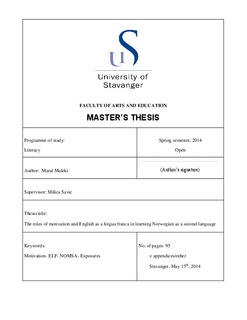| dc.description.abstract | The aim of the present thesis was to investigate the roles of motivation and ELF in the development of the Norwegian language among NOMSA students. NOMSA is a one-year Norwegian language learning program at the University of Stavanger, which acts as the linguistic certificate to study or work in the Norwegian society. This specific feature of the NOMSA attaches higher significance to the students’ linguistic developments and factors affecting the developments. In the current research, it has been tried to investigate two major elements influencing the students’ learning of Norwegian.
The study was conducted with a specific group of NOMSA students who were supposed to have an equal English proficiency as an admission requirement and an A1 level of proficiency in the Norwegian language based on the Common European Framework of Reference for Languages. Thus, it was assumed that in the Norwegian society with the prevalence of English, the students’ motivation to practice and learn the Norwegian language would affect their choice of language for out-of-class exposures. Regarding the role of ELF, it has to be noted that English, which was the common language used for the instruction in the multilingual classroom of NOMSA, could be both a facilitator and a blocker in the students’ use and practice of Norwegian.
Semi-structured qualitative interviews were conducted with ten students who were randomly selected among thirteen volunteers, as well as twoteachers. With a focus on listening and speaking skills, the interviews were designed to obtain detailed information about students’ backgrounds, linguistic proficiencies in English and Norwegian, motivational attributes, and language choices for different situations.
The results which were analyzed based on the Gardner’s Socio-educational model (1985), revealed that the combination of both instrumental and integrative orientations existed in the NOMSA students, though the instrumental orientation played a more prominent role. However, based on their individual differences, the students invested different amounts of desire, time, and effort in the language learning process and opted for English and/or Norwegian in different out-of-class exposures. The ELF, though playing a crucial role in the development of the students’ Norwegian language at the beginning of the NOMSA program, was identified as a blocker in the students’ further use of Norwegian. It was also found that the type and extent of the linguistic proficiency needed for a specific situation, affected the students’ choice of language for that specific situation.
Although the findings of the present thesis revealed great individual variations among the learners of the Norwegian language, the general issues observed might be beneficial in providing conditions which lead to efficient linguistic development. Thus, this study suggests that in the Norwegian society, in which a great deal of English is used, there is a need for teachers, authorities, and educational policy makers to consider motivation-increasing aspects. The need to devise opportunities for the language learners to receive more exposure to the local language emerged as a priority for NOMSA students. | nb_NO |
